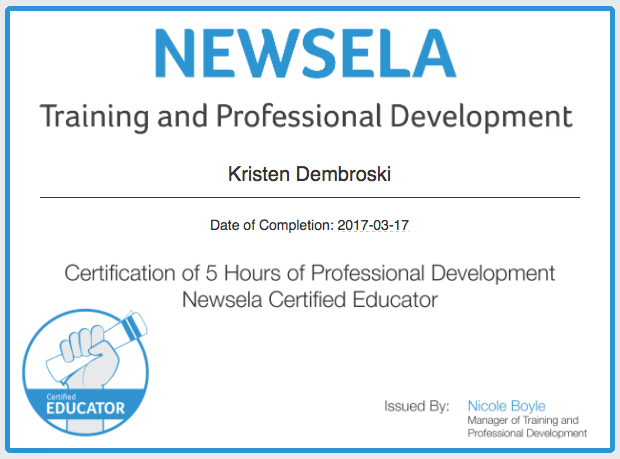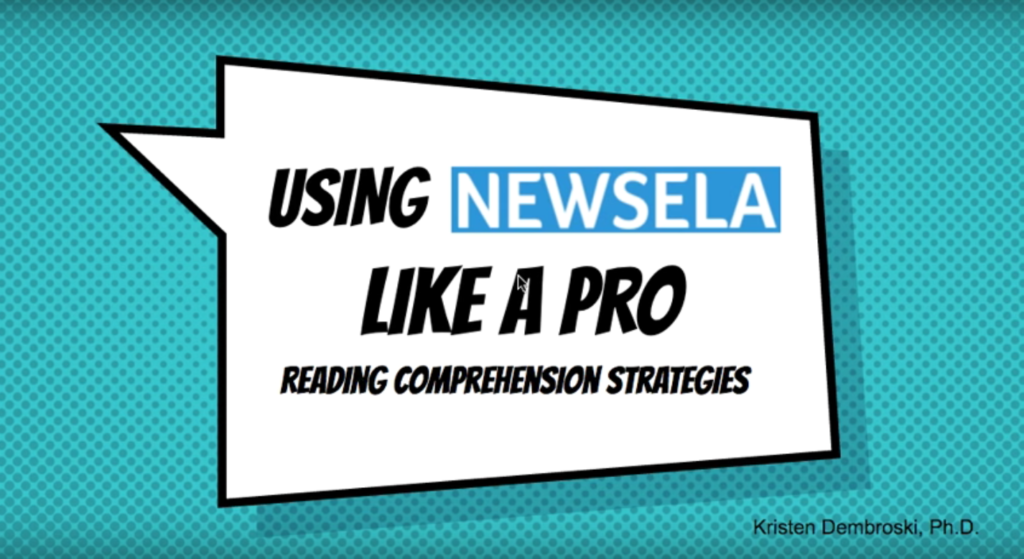Mar
2017
I’m a Newsela Certified Educator

Did you know that Newsela offers professional development opportunities? A plethora of useful tutorials can be accessed through their PD Resources page. I recently completed the training and assessments required to become a Newsela Certified Educator – oh yeah! If you are interested in learning more about this opportunity, here is their run-down. The benefits include:
- A certificate for completion of 5 hours of professional development and training.
- An official certification badge to share on professional platforms.
- The ability to represent Newsela at conferences, training sessions, and lesson plan collaboration.
The 5 hour time estimate is actually pretty accurate, because even though I breezed through the tutorials and quizzes, I spent a long time on the final assessment. The final step is to create a lesson plan that incorporates Newsela PRO features such as a text set, annotations, etc. I am pretty proud of the product I created! Just for fun, I am going to link it below. You know what a fan I am of the novel Spite Fences, so I created this lesson plan as an introductory activity about barriers in society for the novel unit.
Lesson: Barriers in our Society
Teachers: Mrs. Dembroski
Subject: Humanities (ELA and SS)
Grade: 8
Featured Newsela Article: Beyond Barbie: New toys show girls a path toward science and math
Essential Question: What are the ‘fences’ or barriers in our society, and how can we begin to overcome them?
Objectives
- Students will understand that there are invisible barriers in our society that influence our lives.
- Students will be able to read for a purpose and highlight evidence.
- Students will be able to make connections between text selections.
- Students will be able to cite evidence to support their inferences about a text.
Standards
- RI.8.1 Cite the textual evidence that most strongly supports an analysis of what the text says explicitly as well as inferences drawn from the text.
- RI.8.3 Analyze how a text makes connections among and distinctions between individuals, ideas, or events.
- W.8.2.B Develop the topic with relevant, well-chosen facts, definitions, concrete details, quotations, or other information and examples.
Assessment – Create a concept web of the barriers in our society and evidence of those barriers as discussed and cited from the Newsela text set articles.
- 3 (Meets) – Student has included at least 4 accurate barriers in society and appropriate textual evidence that connects to and supports the barriers.
- 2 (Progressing) – Student has included at least 4 accurate barriers in society and has included some textual evidence that connects to the barriers.
- 1 (Limited) – Student has not included a minimum of 4 accurate barriers in society and/or the textual evidence is missing or does not support the barriers.
Outline / Schedule
Day 1 – Novel book walk, introduce “barriers” activity, and model with first article in small and
whole group
Day 2 – Individual work – students read, annotate, and respond to prompts for 3 articles in the
text set
Day 3 – Discussion, begin concept web, adding evidence from articles.
Day 4 – Complete concept web, adding evidence. Submit for assessment grade.
Text Set: Barriers in Society / “Spite Fences – Trudy Krisher
- Growing up multiracial in Seattle
- Inventors and Scientists: Neil deGrasse Tyson
- Giving kids with special needs a sporting chance to form friendships
- Beyond Barbie: New toys show girls a path toward science and math
- With a new arm, a young war victim finds her artistic talent
- Defense chief tanks military’s last barrier to women in combat
- For these police in Kansas City, child hunger is Public Enemy Number 1
- Working-class neighborhood feels division of Olympics
- Polarity is no shield against school bullies
- U.S. says transgender students get to use restrooms they choose
- What are civil rights?
- En pointe and on top of world: Ballerina, film star breaks color barrier
- Law states that California students must learn about LGBTQ history
Lesson Plan
Background – Before reading our novel “Spite Fences” by Trudy Krisher, we will do a book walk and discuss the front and back cover, especially the picture of a fence on the front. We will discuss how a fence is a symbol for division. Fences are physical things in our world that divide us, but there are also ‘invisible’ fences that create barriers in our world, influencing how we behave, what we do, and who we (think we can) become.
Learning Goal – The goal of our Newsela experience is to gain some background knowledge on some of the barriers that exist in our society today. Our essential question is, “What are the ‘fences’ or barriers in our society, and how can we begin to overcome them?”
Activities
- We will begin by reading one article together as a model: Beyond Barbie: New toys show girls a path toward science and math. Students will be seated in groups of 3-4, and will be instructed to read the article out loud to their small group.
Annotation instructions:
Highlight in blue evidence that indicates what problems toymakers noticed and tried to solve by reinventing their dolls.
Discussion Afterward, they will discuss the following 2 prompts:
- What problem are toymakers trying to solve by reinventing dolls and changing their appearances?
- What barrier(s) in society does this article show you?
- How does this barrier affect what people think they can do and/or who they think they can become?
Then, we will come together as a class and discuss our responses. I will model and guide students in understanding that gender expectations are a major barrier in our society, and they can impact what careers or interests people choose.
- Next, students will be instructed to work individually and select 3 more articles from the text set. Each article will have the same 2 writing prompts, as indicated below.
- What barrier(s) in society does this article show you?
- How does this barrier affect what people think they can do and/or who they think they can become?
Annotation instructions: Highlight in blue any evidence you find of barriers in society mentioned in the article.
- Once students have completed their reading and writing prompts, we will come together as a class and make a giant web of all the barriers in society we have noticed through reading Newsela articles (gender, race, ability, identity, financial status, etc.). I will model and guide students in adding evidence from their Newsela articles to the web. Their individual webs will be turned in for an assessment grade. This activity will set us up for further discussion throughout our novel unit of how we can begin to address and break down those barriers.
Accommodations
Though this is an individual assignment, some students (emergent readers) will be encouraged to work in pairs. Others (emergent writers) will be offered the opportunity to verbally discuss their writing prompt responses with the teacher instead of typing them up. Finally, others will have assistance from a paraprofessional with all aspects of the task, and may work with the para in groups of 1 – 4.
Extensions
As an extension, I will encourage stronger readers to read more than 3 articles, and/or to find additional articles throughout Newsela that address the barriers in society. I’d also invite them to highlight in a second color (pink) how people have attempted to address these barriers.
Reflection
This assignment will help students in learning about barriers in society that may affect them or others in their lives. We all confront barriers at some point, but we don’t often think about the barriers that impact others. This activity will help students learn to think beyond themselves. It will also set us up for our novel unit and for exploring ways to overcome those barriers. We will return to the articles after we have finished the novel unit to make a new concept web of ideas, solutions, and inspiration for overcoming barriers in society. We will also brainstorm action steps we can begin in our own community for beginning to break down those barriers and make our world a more inclusive space. We will also connect this learning to the main characters in Spite Fences (Maggie Pugh, George Hardy, Zeke), who pushed against and fought to break down barriers in her own world.
![]()
